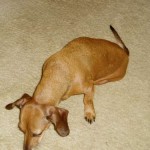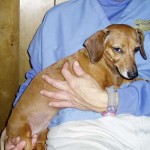CranioSacral Work originated from the work of Dr. William Sutherland, DO in the early 1900’s. In the 1970’s, the term CranioSacral Therapy was coined by Dr. John Upledger, DO from the Upledger Institute. Now, the work is being done in the canine and equine worlds with great success.
The Canine CranioSacral System
The CranioSacral system of the dog is made up of several parts:
1) the bones of the cranium
2) the sacrum or tailbone
3) the spinal column
CranioSacral Therapy includes gentle manipulative techniques of the head, spine and sacrum. However, it is not limited to those areas, nor is it limited only to the physical body systems. The work can benefit the dog on the mental, emotional and energetic levels as well.
Canine CranioSacral Therapy (CCST) is a gentle, non-invasive type of advanced bodywork which facilitates self-healing. It allows the dog to become familiar with the practitioner’s touch and their intention. The light touch used is about 5 grams of pressure (or the weight of a nickel). Five grams of pressure does not overwhelm the body or threaten it. This light amount of pressure may seem subtle, but it is extremely powerful and produces a relaxation response which enables the release of holding patterns. CCST serves as the foundation for a relationship based on trust and understanding. It opens the door for integrating other massage modalities, when the time is right.
A solid foundation of anatomy, physiology, massage and bodywork are essential to the CCST Practitioner. As a licensed massage therapist with natural abilities in animal bodywork and hands-on energy therapies, Eve decided to pursue advanced training in CranioSacral Therapy (in FL) and Integrative Therapies for Animals (in CA). It has been her experience that animals (dogs, cats and horses) are receptive and responsive to this light-touch bodywork. Once they understand her intention, they usually position themselves in such a way as to present the areas that need re-balancing. As an CCST practitioner, Eve can palpate body systems to identify: restrictions, imbalances and asymmetry. Then, attempt to mobilize the connective tissues, allowing the body’s natural tendency for self-correction to occur. Oftentimes with animals: Less is more.
Copyright 2007- 2019 Animal Healing ArtsTM





